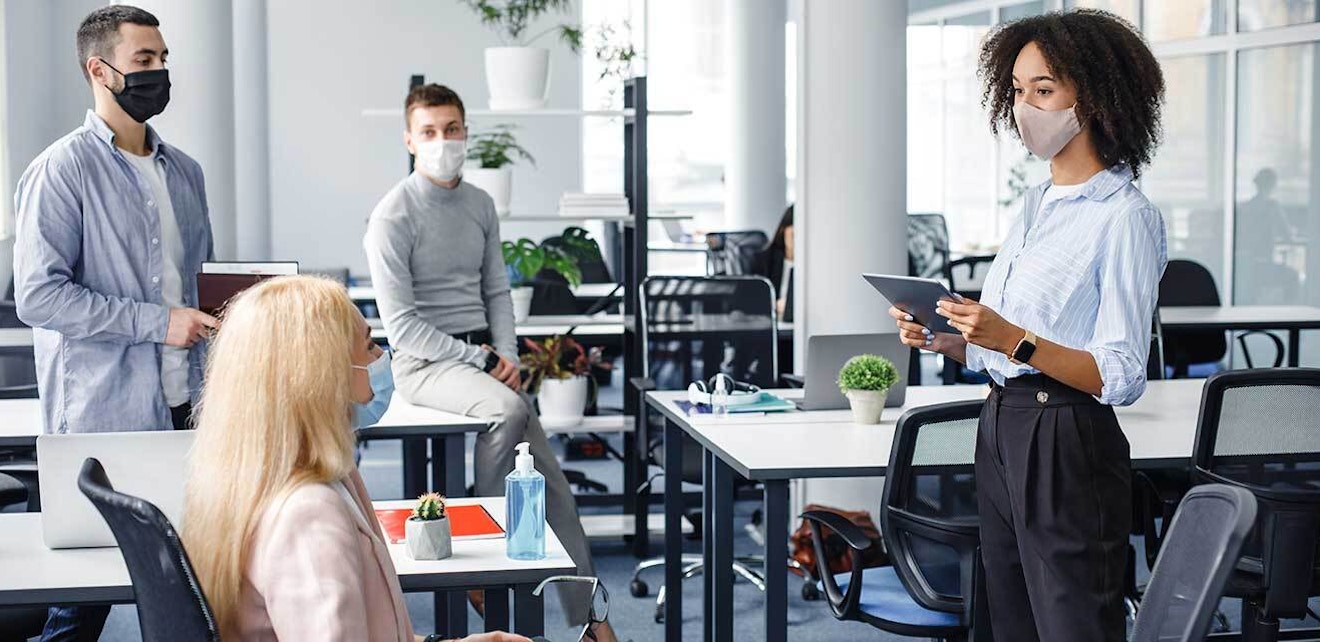Home > Blog
Read Time — 5 minutes
10 Post-COVID Tips for Returning to Work

With the growing availability of COVID-19 vaccines, 2021 is opening the door for many businesses to consider a partial or full return of employees to the workplace. While small and medium-sized business owners feel a sense of urgency to return to business as usual, there are facts to consider about where we are now in the pandemic and practices that can help to ensure the safety of everyone in your workplace.
Currently more than 259 million doses have been administered, fully vaccinating over 114 million people or 34.4% of the country's population. The Biden administration has announced goals to get all Americans eligible for vaccinations by May 1 and to get the nation “closer to normal” by July 4. While vaccinations have helped to reduce the transmission of COVID-19 and many of those at high risk for serious health consequences have been vaccinated, 88.5% of the country is still waiting (or worried about taking the vaccines). There is still much to be done before we reach herd immunity, but progress is happening quickly.
So where do we stand now in terms of what we should and should not do in our workplaces? The CDC recently advised that fully vaccinated people can gather indoors with other fully vaccinated people without wearing masks or physically distancing. They may also gather with a small group, such as coworkers, even if that group has not been vaccinated. Those who haven’t been vaccinated are advised to continue to minimize the number of people they are in physical contact with and to wear masks in public.
If your business is like most others, most of your employees, customers, and visitors have not yet been vaccinated. With this in mind, here are some key safety considerations for gradually returning employees and visitors to your workplace:
10 Post-COVID Tips for Returning to Work
Promote vaccinations
Over the next few weeks, the Biden Administration will deliver vaccines directly to up to 700 community health centers and will double the number of pharmacies and community vaccination centers operating. Simply communicating the availability of vaccines in your local area and the eligibility criteria as they are announced will maximize the number of employees who can gather without masks or physically distancing.
Require face masks
Until it there is clear evidence about whether vaccinated people can transmit the virus, face masks should be required for all employees and visitors, including those who are vaccinated. Keep spare face masks on hand and educate employees on the proper way to wear and handle masks. Noses must be covered.
Stagger a return to work
Some of your employees have been vaccinated. Others can only work effectively in the workplace. Bring these two groups back to work first, then stagger the rest according to vaccinations and need to be in the workplace in order to execute their roles. If an employee lives in an at-risk community or immune-compromised household, extend their ability to work from home.
Have a pre-screening policy
If you can prevent sick employees from putting others at risk, you are taking the most important step in ensuring a safe workplace. Consider having someone check temperatures at the door and turning away employees running a fever. Ask all employees to stay home if they are experiencing symptoms including body aches, a fever over 100 degrees, chills, cough, shortness of breath or difficulty breathing, fatigue, sore throat, congestion or runny nose, nausea or vomiting, diarrhea, or loss of taste or smell.
Be prepared medical emergencies
Be prepared for anyone in your workplace exhibiting sudden signs of trouble breathing; persistent pain or pressure in the chest; new confusion; inability to wake or stay awake; or pale gray or blue-colored skin, lips, or nail beds, depending on skin tone.
Routinely sanitize and disinfect
Following these CDC guidelines for the materials to use, surfaces to clean, and frequency of cleaning.
Adjust your floor plan
Reduce congestion and the potential for face-to-face contact as people pass one another. Consider using tape to mark areas where people can walk to ensure that there are six feet of width between people as they pass one another, especially in intersections. If there are areas where congestion or face-to-face contact is almost impossible to avoid, use partitions to reduce the potential for viral transmission.
Promote physical distancing
Don't hold meetings in closed rooms, if possible. Use open spaces instead. If this isn’t possible, use the largest possible rooms for in-person meetings and limit the number of attendees to only those that must be present. Consider holding virtual meetings or hybrid virtual/present meetings.
Post signage
Remind workers of proper protocols including individual mask-wearing, handwashing, avoiding handshaking, not sharing objects, and other hygienic practices.
Adjust protocols and plans as the situation changes
While it is highly likely the pandemic will continue to subside as more people are vaccinated, there is a possibility that COVID-19 variants could complicate the situation. Be prepared to reverse course and let your workers return to remote work temporarily, as necessary.
There is no doubt the impact of COVID-19 has been greatest for smaller businesses. These ten guidelines can be implemented by businesses of all sizes. When put into place as a matter of policy, they should be all you need to gradually and safely return employees to your workplace.



